
La Rivista Cinematografica (Italy, 1920)
The Domitor Film Journals Project has been growing since last summer. Now under the guidance of Patrick Ellis and myself, the site started as a project to update and expand Luke McKernan’s list for the Bioscope website from 2012. Since the former list was created, online resources have expanded significantly as familiar archives enlarge their digital holdings and new digital collections appear in languages and regions not previously represented. We also have plans to branch out into other types of resources in the future.
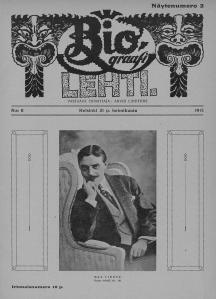
Biograafilehti (Finland, 1915)
When I took this project on, it was clear that it would be a long-term commitment necessitating a lot of crowd-sourced knowledge, not least on account of the range of linguistic skills and research experience needed simply to know about the existence of online resources. The journals project is and will continue to be a work in progress (as ‘expansion’ doesn’t stop), and we are always looking for more contributors, especially in areas of global cinema beyond Western Europe.
One factor I vastly underestimated, however, was the sheer opacity of that key term “digitization,” whose seeming self-evidence conceals a hodgepodge of different practices, technologies, platforms, contexts and assumptions about intended audiences, potential uses and professional standards. Hence, I want to use this blog post to reflect on some issues around digitization and their consequences for thinking about a project like the Domitor Journals Page.
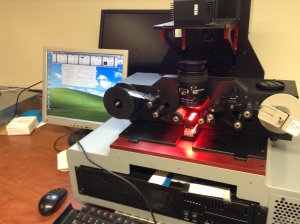
Microfilm scanner, the Moving Image Research Laboratory, McGill University
For many scholars, the term “digitization” reflexively evokes associations (or fantasies) of instant access, permanent storage, high-quality images and/or “data” rife for text mining. But as almost anyone who has worked with these or analogous materials knows, the reality is a lot messier. Digitization involves material labour of various sorts by heterogeneous actors with highly disparate resources. As a result, any list like this one, despite the appearance of uniformity imposed by the design and layout, necessarily harbours a vast array of not-wholly-compatible objects.
To begin with, there is the issue of quantity. The journals themselves, of course, came in all shapes and sizes, ranging from ephemeral productions that may have lasted a few months to well-known titles that ran for decades. More importantly, however, most digitized journals are not ‘complete’ runs; often, only a few issues have been scanned, and even in the case of multi-year digitizations, one frequently finds that not all issues are available within any given year. This fragmentary state of digitizations stems from multiple factors, including copyright hurdles, financial issues, and not least of all the state of the print or microfilm collections at any given archive. (In the case of lesser-known titles, even the archives themselves don’t always know what the years of the ‘complete’ run were.)
From a theoretical standpoint, of course, the very category of ‘completeness’ is anything but self-evident in the serial format of a journal. Whether they lasted 2 years or 80, journals were (and are) inherently incomplete projects; while launches might have been surrounded by all the fanfare and intentionality of a “beginning,” final issues—unlike the finales of most serialized novels or television series—were rarely intended or announced as such. Journals hardly ever end because their mission has been fulfilled. More often than not, they peter out or fold for external reasons: lack of finances, the death of an editor, the decline of readership, obsolescence of a topic, and in some cases—as Weimar scholars know well—the change of a regime.

Mein Film-Buch, yearly supplement to Mein Film (Vienna, 1928)
But even in the rare instances where an archive has digitized every year and every issue of a journal, empirical completeness is still not a given, since journal productions generally included supplements, many of which were highly ephemeral (e.g. yearbooks, photo albums, coupons, membership cards, contests, etc.). These components have often been separated by time, and while some might exist in a library or archive, others only survive in private collections or online sales, if at all.
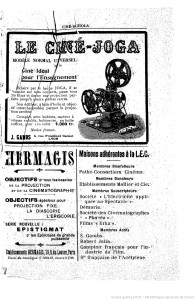
Page from Ciné-Schola (France, 1922)
As important as such quantitative variations are, however, they are dwarfed by variations in quality. There is no single way to digitize a document and no single platform for rendering digitized materials accessible. Digitizations are also undertaken for a variety of different reasons. While some arise from scholarly desires to build research data sets, others (often the ones linked to national libraries and heritage institutions) flow from a desire to preserve cultural patrimony, giving rise to what Rielle Navitski calls the “virtual museum” paradigm. Still others are more akin to fan-based and cinephilic operations. Hence, like the journals being preserved, the digitization projects included in our list are highly diverse. Some digitizations were made from original paper copies, others from microfilm and still others from photocopies. Some are OCR-searchable, others are not. Some offer high-resolution colour images, others third-generation black and white abstractions, which have traveled through several mediations before reaching our computer screen. And while most digitizations strive to respect the integrity of the object as much as possible, others cut, paste and excerpt more or less freely.
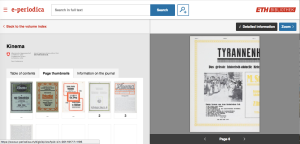
Swiss Federal Institute of Technology, digital library interface
In addition, online platforms differ widely. Some are self-explanatory, others more opaque, outmoded or in need of trouble-shooting. Some are open-access while others sit behind paywalls or offer differentiated access depending on a user’s geographic location. Some are housed in institutions with a relative certainty of continued funding and expansion, while others depend on the benevolent work of one or two people to keep from ‘going dark’. Some, like the Internet Archive, allow multiple download formats, while others—often those more ‘professional’ projects, which come with more stringent copyright pressures—permit only online reading, one page at a time. Relatively few platforms support the kind of statistical word searching most of us know from the Lantern and Arclight applications linked to the Media History Digital Library.
Each of these variations comes with its own assumptions about (and often constraints upon) the type of research one can do with these objects.
So what do these reflections mean for the Domitor Journals Page?
First, we have made a conscious decision to embrace the diversity of journal digitizations rather than disparaging it. As default information, we provide the titles and years available for any given journal, while offering some informational notes (usually on questions of access) where this seemed helpful. If users are looking for a known article or image, they will need to find the relevant year of the journal (if available) and hope for the best. If they wish to perform word-searches, they will be limited to certain sources (which themselves offer highly variable hit rates) and not others. But these journals also contain myriad “unknown unknowns,” and we hope users will also take the opportunity to dive in, explore, and see what they stumble across. There are worse ways to discover new research projects than by meandering through the pages of an historical journal. We also invite readers to tell us about a given journal, its history or cultural significance (more on this below).
Second and no less importantly, we believe that digitization itself should be part of the story. As much as these lists provide a record of print publications from the era of early cinema (with all of the Domitor caveats about that term’s global polysemy), they also bear witness to the highly disparate forms of labour (digital and analogue) that have allowed these objects to survive to the present day.[1] They remind us that preservation (including and especially digital) is never a given and that “ephemerality [must be] made to endure.”[2] They carry the traces of digital trial and error, of different intentions and motivations for ‘going digital’, of struggles with time and resources, but also of the cinephilic passions and communal exchanges that digital technologies have helped to sustain and transform.
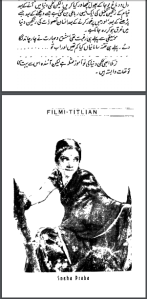
Filmtitlyan (India, 1945)
Viewing our journals project in this way, one could argue that ‘amateur’ digitizations are every bit as valuable as big-budget operations, if we approach them not as lesser versions of the ‘real’ thing, but as opportunities to learn more about how digitization actually works in our present era: an era marked by decentralization, budget cuts and the outsourcing of labour, but also by the digital enabling of cinephilic collecting, participation and preservation.[3] Indeed, almost everything Hito Steyerl wrote about the ‘poor image’—those low-res pirated video files that circulate in the less official networks of the Internet—could be easily said of the ‘poor digitization’. Poor digitizations “mock the promises of digital technology,” but they also reveal a lot about the state of digital economies today. Poor digitizations travel, sometimes in underground circuits and shadow economies, existing alongside the more official work of libraries, archives and museums. Poor digitizations sit within a perceived class structure, with high-res colour editions at the top and hazy digitized photocopies at the bottom. (The question is, should we as early cinema scholars reproduce this hierarchy unquestioningly, or should we be interrogate its assumptions?). And poor digitizations say a lot about geopolitical asymmetries, attesting not only to the so-called ‘digital divide,’ but also to the unequal access to funds for archival preservation more broadly.
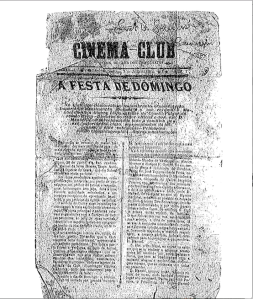
Cinema-Club (Brazil, 1912)
If we approach a project like ours with the assumption that only certain standards of professionality will do (be it defined in terms of resolution, colour, access, searchability or any other criteria), ‘poor digitizations’ will always appear derivative, functioning as a preview (of a proper archival experience to come) or a trace (coming after the loss of an original). But viewed on their own terms, such digitizations can suggest great labours of love. Adapting a line from Steyerl’s article, we could say that “the condition of the [digitization] speaks not only of countless transfers and reformattings, but also of the countless people who cared enough about [these journals] to convert them over and over, to add [annotations], reedit, or upload them.” Hence, we hope the users of the Domitor Journals Page will take interest in the stories (admittedly not always knowable) behind these digitizations, and that this page might serve not only as an aid to research on early cinema, but as an occasion to reflect on the history and conditions of its survival in analogue and digital archives, as well as the uneven conditions of digitization today.
The third consequence of the above reflections is that a project like this is at its best if it can continue to promote the kind of labours of love we share. To this end, in addition to “acknowledging” the contributions and exchanges that make the Journals Project possible, we also wish to embrace such collective intelligence as an opportunity. After all, sharing has a long and venerable media tradition, which hardly began with advent of film. (Early film archives themselves took up many of the structures of sharing well known from institutions such as lending libraries.) Many book historians have argued that the digital era is reviving reader-centered participatory practices common to the pre-modern era, such as comments, annotations and marginalia (e.g. here and in responses here). We highly encourage such a reader-centred engagement with the Domitor Journals Project, and we believe it can help these journals—so many of which are forgotten today—come alive in the present.
In this spirit, we plan to trial the “annotated web” browser extension at hypothes.is and create a Domitor annotation group for the journals page. This will allow any member or the group to attach commentary to any word in our journals list, to read comments by others (by clicking on highlighted words), and to respond to other comments. Such discussions ‘in the margins’ of the computer screen might serve any number of purposes. Members could let other users know which issues of a given journal are available or what aspects are missing. But they might also be inspired to tell the community more about titles on the list (their editors, histories, contributors, unique features, or any other aspect you find worthy and interesting), about the archives housing them, or about the history of their preservation. Users might also pose questions, respond to queries by others, propose spin-off projects and so on. The potentials are numerous.
In this way, we hope that users might approach the Domitor Journals list not only as a collection of historical sources to be mined for individual research projects, but also as an occasion for scholarly and cinephilic discussion. In other words, we hope that this journal database could itself become a living archive of shared film-historical knowledge, one that is reader-driven rather than curator-driven, and one in which present dialogue is no less vital than the voices of the past. What better place to try out such a model of collective knowledge around early cinema and its legacies than the Domitor community.
[1] For more reflections on this point, see for example Lisa Gitelman, Always Already New: Media, History and the Data of Culture (Cambridge: MIT, 2006), 123-124.
[2] Wendy Hui Kyong Chun, “The Enduring Ephemeral,” Critical Inquiry (Autumn 2008), 171.
[3] In many cases, one can see a parallel here to Girish Shambu’s reflections on Internet cinephilia in his well-known book The New Cinephilia (Montreal: Caboose, 2014). I would only add that, in the context of film history and historical journals, cinephilia today should be expanded to include a passion for forms of cinema beyond art and entertainment (as in the Orphan Films symposium).


